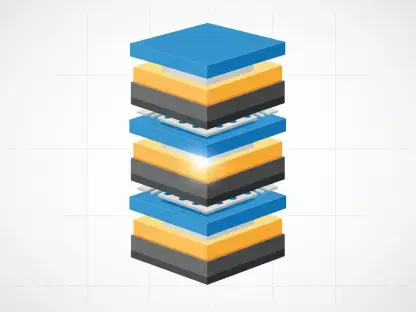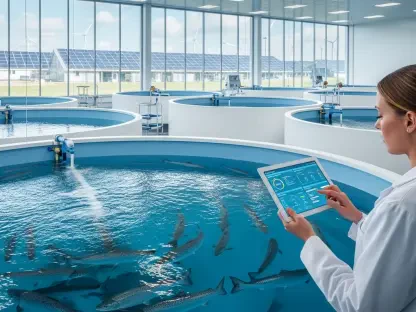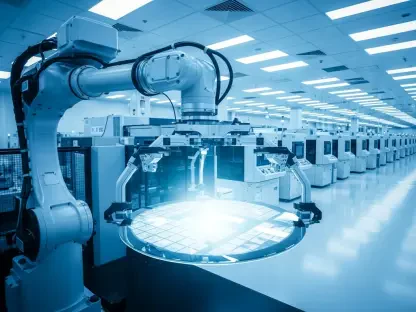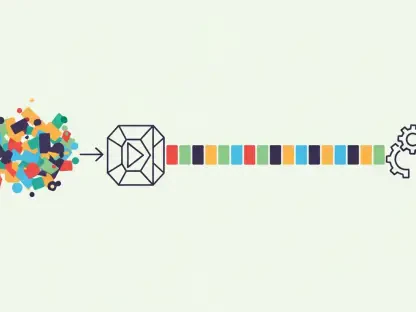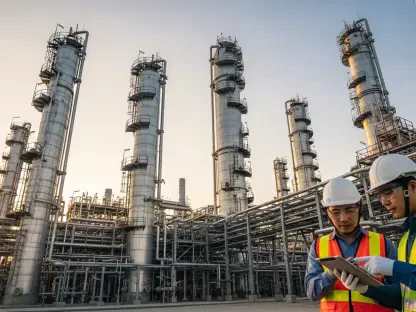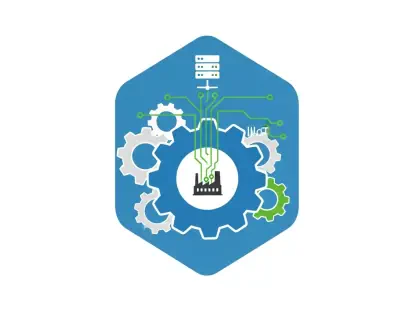A groundbreaking initiative by the Fraunhofer Institute for Manufacturing Technology and Advanced Materials (IFAM) and the Bremen University of Applied Sciences (HSB) has pioneered a method to recycle polypropylene packaging waste into filaments for 3D printing. This innovative process tackles the dual challenge of reducing plastic waste and promoting eco-friendly additive manufacturing, showcasing the potential for significant environmental benefits.
Addressing the Plastic Waste Challenge
The Scale of Plastic Waste
Post-consumer plastic waste presents a substantial challenge, primarily due to its heterogeneous and often contaminated nature. The pressing need to address this issue is heightened by the surge in household plastic waste in Germany, which has seen a dramatic increase in recent years. This alarming trend accentuates the urgency for effective waste management solutions that can handle the complexity of post-consumer plastics. While industrial residues are relatively easier to recycle due to their uniform composition, household plastic waste is notorious for its diversity, making it a formidable obstacle in traditional recycling processes.
Fraunhofer IFAM and HSB Collaboration
The collaboration between Fraunhofer IFAM and HSB exemplifies an innovative approach to repurpose challenging-to-recycle packaging materials. By acquiring polypropylene waste from a dedicated sorting plant, they have set a precedent for transforming post-consumer plastics into valuable resources for advanced manufacturing. This initiative not only addresses the escalating issue of plastic waste but also pioneers new methodologies in the recycling industry. The synergistic efforts of Fraunhofer IFAM and HSB have culminated in a process that ensures the preparation of waste materials for high-quality applications, thus turning a problem into an opportunity for innovation and sustainability.
The Recycling Process
Waste Processing Techniques
HSB’s Laboratories for Circular Economy play a pivotal role in the initial stages of waste processing, employing advanced techniques such as grinding, washing, and separation. These processes are crucial in preparing the polypropylene waste for further refinement. The waste undergoes a series of treatments, including float-sink separation and near-infrared technology, to remove contaminants and unsuitable materials. This meticulous preparation guarantees that the waste achieves the necessary purity levels required for 3D printing applications.
Once the waste reaches an appropriate level of cleanliness, it is further processed to ensure consistency. This involves grinding the material to a specific grain size and drying it to attain an astonishing purity level of 99.8%. The resulting homogeneous polypropylene is not only clean but also retains the essential characteristics needed for 3D printing, such as durability and flexibility. These rigorous processing stages are integral in converting post-consumer waste into a viable material suitable for sophisticated manufacturing processes.
Creating High-Quality Filaments
After achieving the requisite purity and consistency, the prepared polypropylene waste is further refined at Fraunhofer IFAM using industrial extruders. This stage involves precise adjustments of mechanical parameters such as screws, temperatures, pressures, and speeds to produce a uniformly round plastic strand suitable for 3D printing. The level of accuracy required in this phase underscores the complexity of transforming waste into high-quality filaments.
The resulting homogeneous polypropylene filaments exhibit properties essential for successful 3D printing, including consistency, durability, and flexibility. The meticulous approach taken in refining these filaments ensures that they meet the stringent requirements of 3D printing technology. This meticulous process not only exemplifies the feasibility of using recycled materials in advanced manufacturing but also sets a benchmark for future innovations in the field.
Applications and Future Innovations
Successful Implementation
Initial projects using these recycled filaments have demonstrated their effectiveness in 3D printing various packaging components, including plastic caps. The success of these trials highlights the viability of converting post-consumer waste into valuable materials for advanced manufacturing. These accomplishments validate the potential of recycled filaments in producing high-quality, functional products.
The implications of this success extend beyond mere feasibility; it signifies a potential shift in the manufacturing industry toward more sustainable practices. By proving that recycled materials can meet the high standards required for 3D printing, this initiative encourages the adoption of similar methods across various sectors. The initiative’s success also serves as a testament to the potential of innovative waste management techniques in contributing to both environmental and economic sustainability.
Expanding Potential Uses
Looking ahead, Fraunhofer IFAM and HSB plan to further enhance the properties of these recycled filaments by incorporating additional materials, such as glass fibers. This could significantly improve the mechanical properties of the plastic, making it suitable for more demanding applications in industries like aviation and automotive. The addition of reinforcing fibers can enhance the strength, rigidity, and thermal resistance of the filaments, broadening their range of use.
Such innovations could pave the way for recycled materials to compete with traditional, non-recycled counterparts in high-performance applications. The exploration of new compounding techniques represents a forward-thinking approach to material science, with the potential to revolutionize various industries by providing sustainable alternatives without compromising on quality or performance. This forward-looking strategy underlines the adaptability and potential of recycled polypropylene in addressing diverse industry needs.
Regulatory and Environmental Impact
Packaging and Packaging Waste Regulation
The recent regulations mandating a significant increase in recyclate content in packaging underscore the urgency for initiatives like this one. By 2035, these regulations require recyclate content in packaging to reach between 25% and 65%, depending on the plastic type and product. This project directly supports these regulatory goals, promoting the use of recycled materials in manufacturing. By aligning with these stringent requirements, Fraunhofer IFAM and HSB’s efforts contribute to the broader regulatory framework aimed at reducing plastic waste and promoting sustainability.
These regulations highlight the importance of innovative recycling methods in meeting legislative demands and addressing environmental concerns. As manufacturers strive to comply with these mandates, the demand for high-quality recycled materials is expected to increase, further driving advancements in recycling technologies. The initiative by Fraunhofer IFAM and HSB provides a viable pathway for manufacturers to meet these regulatory requirements while fostering a more sustainable industry.
Contribution to Circular Economy
The initiative significantly contributes to the circular economy by enhancing resource efficiency and mitigating climate change. By converting waste into valuable materials, it addresses the dual goals of reducing environmental impact and promoting economic sustainability. The emphasis on increasing demand for recycled materials, as highlighted by Dr. Silke Eckardt, is crucial in driving this transition toward a circular economy.
Promoting a circular economy involves not only recycling and reusing materials but also rethinking product design and consumption patterns. This project exemplifies how innovative recycling techniques can play a pivotal role in this broader environmental strategy. By demonstrating the feasibility and benefits of using recycled materials in advanced manufacturing, the initiative paves the way for broader acceptance and adoption of circular economy principles across various industries.
Broader Innovations in Sustainable Solutions
Other Notable Projects
Globally, numerous projects are making significant strides in developing sustainable materials for 3D printing and packaging. The University of Birmingham, for instance, has created biodegradable resins, while the University of Washington has developed compostable packaging solutions from unconventional materials like coffee grounds and mushroom spores. These innovations underscore the diverse approaches being explored to tackle the plastic waste problem.
Each of these projects addresses unique challenges but shares a common goal: reducing the environmental impact of plastic products. By leveraging innovative materials and techniques, these initiatives collectively contribute to the development of more sustainable manufacturing practices. The success of these projects serves as a testament to the potential of interdisciplinary research and collaboration in addressing global environmental challenges.
Fraunhofer IVV’s Efforts
In addition to the efforts by Fraunhofer IFAM and HSB, the Fraunhofer Institute for Process Engineering and Packaging IVV is also making notable contributions to sustainable packaging solutions. The institute is exploring the use of alternative materials such as peatland plants and bamboo to create paper-based packaging. These efforts aim to reduce reliance on traditional materials like wood, thereby offering a more sustainable option.
Fraunhofer IVV’s work exemplifies the broader trend of seeking alternative materials to address the environmental impact of packaging. By developing sustainable packaging solutions, the institute contributes to reducing wood import rates and promoting biodiversity. These innovative approaches highlight the potential for sustainable materials to play a crucial role in the future of packaging, ensuring that environmental considerations are integral to product design and manufacturing processes.
Towards a Sustainable Future
The Fraunhofer Institute for Manufacturing Technology and Advanced Materials (IFAM) and the Bremen University of Applied Sciences (HSB) have launched a groundbreaking initiative to recycle polypropylene packaging waste into filaments for 3D printing. This innovative process aims to address two pressing issues: reducing plastic waste and fostering eco-friendly additive manufacturing. By converting discarded plastic into usable filaments, the project promises considerable environmental benefits.
This method not only repurposes what would otherwise clog up landfills, but it also supports sustainable practices in the rapidly growing field of 3D printing. The collaboration between IFAM and HSB leverages their expertise in advanced materials and sustainable technology, showcasing the potential for significant advancements in environmental conservation and manufacturing efficiency. Through this initiative, they are setting a precedent for how waste materials can be transformed into valuable resources, underscoring the role of innovative technologies in driving ecological progress.


